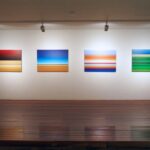증식과 변주의 간주곡
글 : 김미진 (세오갤러리 디렉터, 조형예술학 박사)
글 : 김미진 (세오갤러리 디렉터, 조형예술학 박사)
이 경의 회화는 수평의 단편적인 직면들로 이루어진다. 화면 속의 가늘고 긴 단면들이 만들어내는 색채의 섬세한 변주는 우리를 둘러싸고 있는 풍경을 그려낸다. 이 경의 그림은 도시를 벗어나 속도를 내며 달리는 자동차나 고속 전철의차창 너머에서 만나게 되는 시간으로 빨려 들어가는 풍경화들이다. 냉정하고 기하학적인 공간 구성이지만 흰 모래와극히 대비되는 검푸른 바다, 석양이 오버랩 된 바다와 하늘, 푸른 들판과 나무가 있는 초원 등의 이미지가 풍성한 감성과 결합되어 또 다른 세계의 풍경을 만들어 낸다.
흰 모래의 구릉, 푸른 들판 속에 펼쳐진 꽃밭을 짐작하게 하는 한줄기 빨간 선, 짙은 청색을 띄는 호수 주변에 보라색물감이 뿌려진 듯 깔려있는 라벤더 꽃밭 그리고 차가운 북극 풍경 또한 예리한 작가의 체에 걸러져 면으로 조합되어그려진다. 결국 풍경의 요소는 하나도 없고 오직 색채만 있을 뿐이다.
그러나 색채의 상징과 면의 구성은 시간을 흘려 보내며 기억을 자극해 향수를 내뿜으며 예민한 감성을 자극한다. 이것은 풍경 전체를 증식시키고 무한히 변주하여 시작하지도 끝나지도 않을 듯한 수평적인 리좀식 공간을 만들어 낸다.
다시 말해, 시간과 공간이 분해된 색면으로 조합 되었지만 그 안에는 눈에 보이지 않는 마음의 정서가 담겨있는 것이다. 그래서 우리는 새벽의 공기를 머금은 듯한 아스라한 풍경까지 보게 된다. 형상은 단편화되어 1차원처럼 보이지만현실 공간, 4차원의 시공간, n차원, 무한차원이라는 과학적인 공간부터 한계를 볼 수 없이 늘어나는 프랙탈 공간까지모두를 담고 있다. 그리고 시간과도 결합되어 보는 사람의 기분에 따라 움직임이 다르게 느껴짐으로써 선과 면의 복제와 반복된 이미지지만 그 가운데 비정형적인 자기 조직화의 공간이 숨어들어 있다.
이것은 동양화의 능선능선마다 안개같은 여백이 표현되어 풍경과 감흥이 하나되는 정경묘융情景妙融과 같은 미적 경험을 제공한다. 이 경의 회화 속의 단편화 된 색채는 층층히 조합되어 아이러니하게도 풍경과 보는 이가 하나되게 하는 내재적 관계를 형성한다. 이것은 화면 구성과도 연결되는데 위에서 내려다보는 신적 창조자 관점이 아니라, 풍경과내가 하나되는 수평적 관점으로 그려진 것이다. 마치 속도감으로 빨려 들어가 풍경과 융합되는 역동적인 맥박 같은 그림이다.
결국 작가는 이성적으로 색채를 고르고 분할하여 사용하지만 작가의 감성이 개입된 추상적 배치로 작품은 한정되지않고 우리의 생각, 마음, 육체 속에 각인된 풍경으로 전이되면서 독특하며 주관적인 풍경으로 전환된다. 그녀가 선택한 소재인 바다, 아침, 안개, 모래, 하늘 등의 자연적 요소들은 독립되면서도 서로가 흡수, 가감, 수용되어야만 비로소완전한 풍경으로 다가온다. 이 경의 회화는 대상을 완벽하게 분석하면서 또한 대상과 감상자를 하나 되게 하는 회화의본질을 추구한다. 그리고 시시각각 다른 바람이 스치는 것처럼 다가와 우리의 감각을 울리며 감응시킨다.
2006.ⓒ 김미진
Kim, Mi-Jin (Director, SEO Gallery . Ph.D. in Plastic Art)
Lee Kyong’s paintings consist of horizontal and fragmentary faces. The landscape surrounding us is described on the canvas by the delicate variation of colours produced through fine and long sections. Lee Kyong draws landscape paintings, which are based on tempo and encountered out of the window of a car or a bullet train running fast in the country. She creates the landscape of, as it were, another world through combining abundant human emotions with such images as the dark blue sea, which is clearly contrasting with white sand and whose space is heartedly and geometrically composed; the sea and the sky overlapped with the sunset; and a green field and a plain covered with trees.
The artist’s sharp senses do not fail to catch such scenery as comprises a white sand hill, a ray of red light reminding us of a flower garden cultivating on a green field, a violet lavender bed lying around a dark blue lake, and a cold North Pole landscape. After all, in her pictures, there are no factors of landscape but just colors.
However, the symbol of colours and the composition faces instigate our memories and provoke our sensitive emotions while running out time. This creates horizontal rhizome-type spaces that do not seem to start nor end but just multiply and infinitely vary the entire landscape.
In other words, her paintings are made up of colour fields that disjoint time and space but they contain invisible emotions of a human heart. As a result, they enable us to see the indistinct landscape that seems to harbour the early-morning air. Their shapes are fragmented and look like one dimension but they comprise all the spaces including the real space, four-dimension space-time, n-dimension or infinite-dimension scientific spaces, and infinitely increasing fractal spaces. Moreover, the pictures are combined with time and everybody feels their motion from a different perspective depending upon his/her mood. The lines and faces are reproduced and their images are repeated in the pictures, which hold atypical self-organizing spaces.
Such artistic techniques contribute to our aesthetic experiences of a pathetic scene exquisitely harmonized, which is the fusion of landscape and human emotions applicable to Oriental paintings where ridges have mist-filled spaces. The fragmented colours in Lee Kyong’s paintings are compounded step by step and ironically form the internal relation that unites landscape with appreciators. This fact is connected to the constitution of a canvas that is drawn not from the viewpoint of God the Creator who is overlooking everything, but from a horizontal perspective that combines landscape with appreciators. That is why the pictures look like dynamic pulses that become merged with landscape moving so fast.
The artist uses her reason to select and divide the colours, and her paintings are not limited to an abstract layout meddled with her emotions but converted into a unique and subjective landscape, which is carved our thoughts, mind, and body. The landscape is completed only when her-chosen natural subject matters such as sea, morning, sand, and sky are independent but absorbed, added or subtracted, and accommodated into each other. Lee Kyong’s paintings pursue the essence of paintings since they thoroughly analyze the objects and unite the objects with the appreciators. They also incite and move our senses in the same way as different kinds of wind blow at us moment by moment.
2006 © Kim Mi-Jin
 Collected Landscape – Solo Exhibition, Seo Gallery, 2006
Collected Landscape – Solo Exhibition, Seo Gallery, 2006